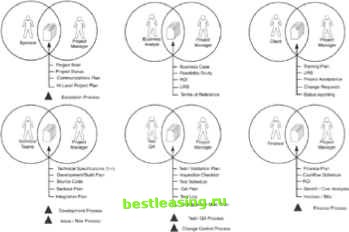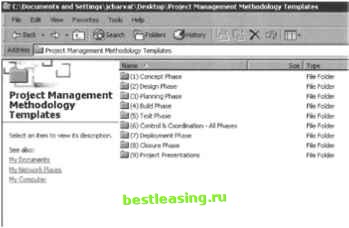

 |
 |

|
Промышленный лизинг
Методички
Template Selection I recently bought a pair of snow boots from the Timberland Web site. After selecting the boots, I was immediately offered accompanying winter socks an excellent way to cross-sell something I had not planned to purchase. Likewise, when choosing a methodology, you would surely need some templates to accompany it. After you have defined the methodology, add the appropriate methodology templates (e.g., concept phase would require a business case template and a feasibility template). However, you must be very selective with project templates, as there are essentially hundreds of forms, checklists, and templates you could use. If you select every template, youve created a monster. Select too few, and you are short. Through extensive experience on many different projects, I offer a complete project template toolkit which is available on my personal website www.jasoncharvat.com/sales.html. This toolkit can be used with any project methodology and for each project, you merely identify and select the relevant templates you need. Figure 7.1 shows that each stakeholder in the project plays an important role. Sometimes, stakeholders require a complete set of templates for their tasks. Other times, a stakeholder needs only specific templates (e.g., QA stakeholders require QA-related documentation).  Figure 7.1: Project templates per project role. Purpose of Project Templates The definitions and templates found in this book are best described as generic because certain methodologies and companies may have their own variations of the templates they need. Therefore, project templates should be modified based on the specific methodology to be used or tweaked to suit your company standards. Figure 7.2 provides a summary of the contents of the CD-ROM that I provide on my website. Once you obtain the CD-ROM, there are 120 different project templates available for use. The structure is listed in possible phases you could expect to encounter on a typical project. If you have just started your project, you would open the Concept Phase folder and locate the relevant template.  Figure 7.2: Contents of CD-ROM. Master Record Index Template for Project Start The master record index is used at the start of a project. It lists all documents used during the initial phase of the project and indicates status of the documents (i.e., approved or not approved). The master record index assists in auditing and provides project managers with a quick reference of documents required for the project. This is a one-page document and the template is simple to complete. Feasibility Report Template The feasibility report is a formal report that provides the findings of the feasibility study, which is undertaken before the project starts. The report includes an overview of the request, the reasons for initiating the project, the findings of the study, recommendations either for going forward or for rejecting the request, and the estimated cost and effort of the project. If available, it also summarizes the expected advantages to the group (e.g., cost savings, less maintenance effort) of the new deliverable. Product Brief Template The product brief document describes the aim, benefits, and objectives of the proposed product. It could describe the development of a new photocopier, satellite, or medical drug. Additionally, it establishes the parameters for the work to be done, including tasks to be performed (scope) and tasks not to be performed (outside of the scope of the project). It may include expected deliverables, risks, the project team and their roles, and measures of success (close-out criteria). Product Plan Template The product plan document describes where the product will compete, development time line, scope, and resources. User Requirements Specification (URS) Template The URS document describes, in business terminology, the clients project requirements. Many failed projects have had either no or poorly documented user requirements. The client should typically complete the URS, but this does not always happen. In any event, be prepared to complete this template for the client, because the URS sets the entire direction of the project. Without a URS in place, you may encounter clients asking for more than what was originally bargained for. The URS usually precedes a system requirements specification document. To ensure that the URS template is properly completed, engage the client in a series of discussions, questionnaires, or workshops to 1 2 3 4 5 6 7 8 9 10 11 12 13 14 15 16 17 18 19 20 21 22 23 24 25 26 27 28 29 30 31 32 33 34 35 36 37 38 39 40 41 42 43 44 45 46 47 48 49 50 51 52 53 54 55 56 57 58 59 60 61 62 63 64 65 [ 66 ] 67 68 69 70 71 72 73 74 75 76 77 78 79 80 81 82 83 84 85 86 87 88 89 90 91 92 93 94 95 96 97 98 99 100 101 |